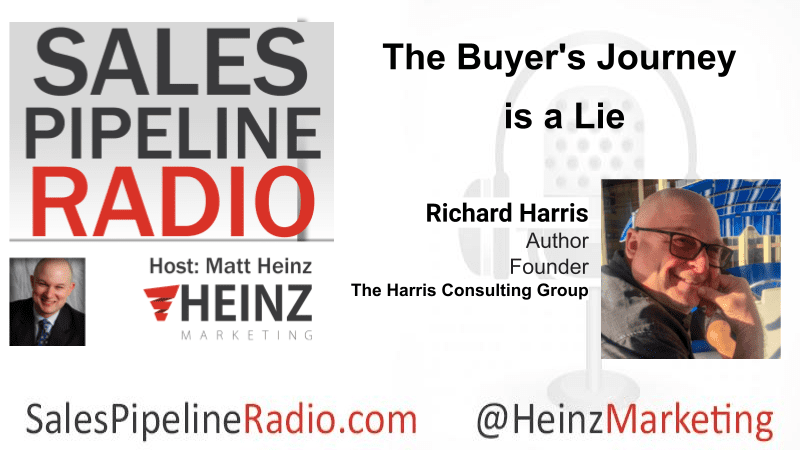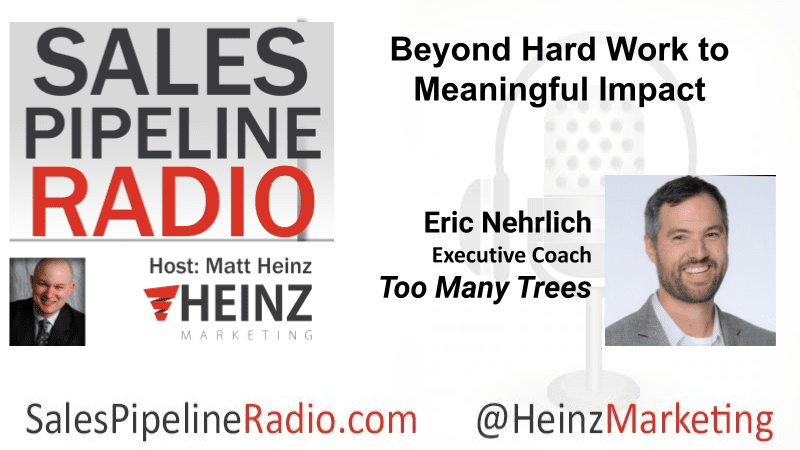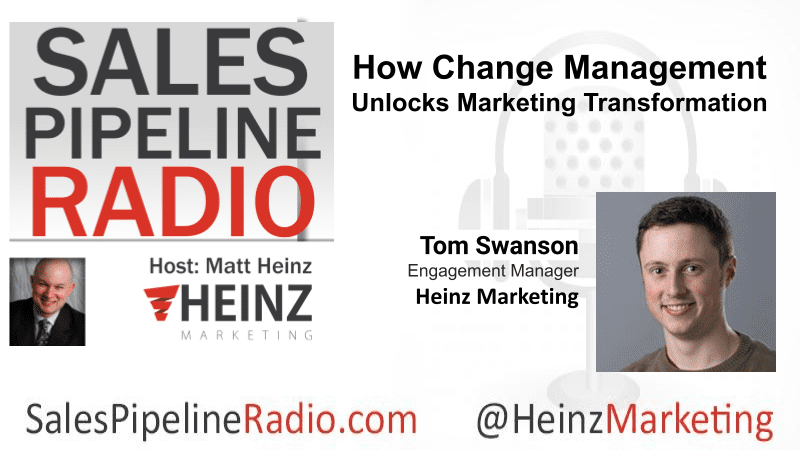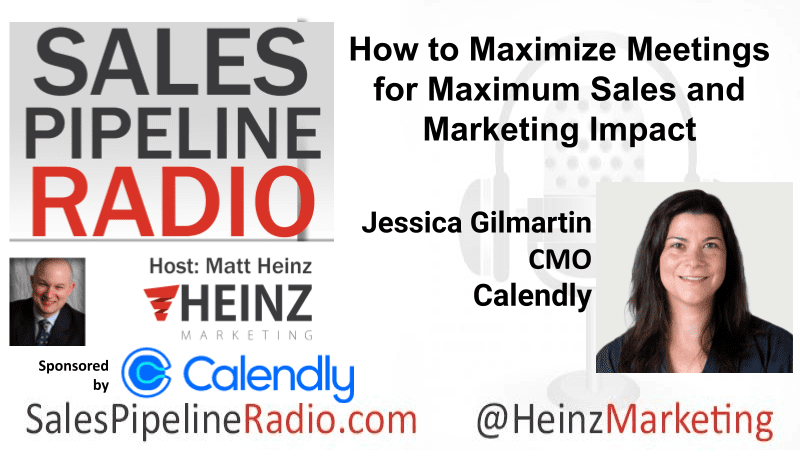Sales Pipeline Radio, Episode 355: Q & A with Richard Harris @rharris415

Summary
Matt interviews the best and brightest minds in sales and Marketing on Sales Pipeline Radio.
By Matt Heinz, President of Heinz Marketing
If you’re not already subscribed to Sales Pipeline Radio or listening live Thursdays at 11:30 am PT on LinkedIn (also on demand) you can find the transcription and recording here on the blog every Monday morning. The show is less than 30 minutes, fast-paced and full of actionable advice, best practices and more for B2B sales and marketing professionals.
We cover a wide range of topics, with a focus on sales development and inside sales priorities. You can subscribe right at Sales Pipeline Radio and/or listen to full recordings of past shows everywhere you listen to podcasts! Spotify, iTunes, Blubrry, Google Play, iHeartRADIO, Stitcher and now on Amazon music. You can even ask Siri, Alexa and Google or search on Audible!
This week’s show is entitled, “The Buyer’s Journey is a Lie“ and my guest is Richard Harris, Founder of The Harris Consulting Group and author of “The Seller’s Journey Your Guidebook to Closing More Deals with N.E.A.T Selling“.
Tune in to Learn About:
- How to restore the human element in sales amid the rise of AI.
- Learn about Richard’s N.E.A.T Selling Method
- Discover strategies for navigating the complex, multi-decision maker environment of B2B sales.
- The importance of accountability in the selling process.
Watch the video, listen in below and/or read the transcript below.
Matt: All right. Welcome everybody to another episode of Sales Pipeline Radio. My name is Matt Heinz. I’m your host. Thank you so much for joining us today. And just excited that you made us part of your day today.
If you’re listening or watching this on demand, thank you so much for subscribing, for downloading. This is episode, I believe around 355 of Sales Pipeline Radio going back several years. And if you want to check out past episodes, future episodes, always available at salespipelineradio.com. Very excited today to have my friend, Richard Harris, join us today.
He is the founder of the Harris Consulting Group, (www.harrisconsultinggroup.com) and the author of this book, The Seller’s Journey.
Richard, I’ve known you for a long time. You’ve been doing this for a long time. You’ve been writing, speaking. What about this topic was important enough to write a book?
Richard: It’s interesting cause there’s always so many sales books. And part of me was had the imposter syndrome of, Oh, great. Here comes another sales book. Right? And I eventually got over that after a while.
And I wanted to tell it in a slightly different way. The couple of things that have been coming up over the last several years, not just because of AI is, feels like there’s this lack of humanity in sales, right? And it comes and goes, right? Like I think we saw, you know, when COVID hit, I think we saw a lot of humanity come back into the real world in a lot of ways and into sales.
And then of course, as things, opened back up and we got back to selling and we had all this great fundraising. It was another mad dash and rush to automation which I think is also what’s happening now. So it was sort of interesting that I started writing this as the AI was coming on. A lot of the tools that are out there now aren’t, were just being built. They weren’t quite ready. So, that was a big piece was about the humanity piece. I talk a lot about, you know, me, I talk a lot about mental health and mental health and sales. So I wanted to write about you know, what is it like? the first section is called, Yes, I’m in Sales.
Let’s be proud of what we do. That doesn’t mean we need to be arrogant, but we can be proud. And then I wanted to give away some tactics. There’s 13 tactics in the book of like, what do you do when it’s procurement that you’re talking to? And how do you prevent discounting conversations from going so deep into the discount? Like real tactical stuff.
So I put it together as part mindset and then tactical. Because I feel like those are the two things I know the best in that world. So that, that’s what prompted it I just felt like this little piece that was missing.
Matt: I appreciate it. I didn’t know what I was going to get when I got my copy and I got this very accessible, easy to read book. you talk about practical– I mean, there are email templates in here, there are voicemail scripts, there’s how to set up calendar invites and what to write in the invitation subject line. Great best practices throughout this book.
There is no buyer’s journey. There’s a seller’s journey that we create, often with marketing, right? And you’re, you’re a marketing guy, you know, and you need these people to come through this journey with the ability to have an amazing experience. There’s a buyer’s experience that matters.
There’s no such thing as a buyer’s journey, even for all those people who say, well, what about, there’s 70 percent of the way down the pipe through the rabbit hole before they talk to a salesperson. It’s the same thing. It’s about an experience. And even before, even before they decided to Google you or however they found you, they had some crappy experience.
They had an experience that they said, I need to resolve this pain. And if you think about it, Matt, how many apps do you have on your phone that you don’t use?
It’s the majority of them. It’s like dozens. Right. And either A, they’re no longer helpful, or B, we’ve gotten lazy and we haven’t deleted them, or C, They’re terrible experiences, right?
Like I got a ton of game apps on my phone that I don’t use. I might, if I get stuck in an airport but there are tons of things on there that were just horrible experiences. So there’s no such thing as a buyer’s journey. It’s just a buyer’s experience. Hence the title of the book, The Seller’s Journey.
Matt: I love the way you phrase that. Thank you so much for talking today on Sales Pipeline Radio with Richard Harris, the author of this fantastic new book, The Seller’s Journey, and you can see it if you’re watching on video right on his shirt is the N.E.A.T Selling Method. And I love the clarity in the simplicity of this.
There’s too many methodologies out there with like 16 D’s and four C’s and just, it gets a little more complicated than I think we need to make it. Talk about the origin story of N.E.A.T. Selling and then if you could unpack what NEAT stands for, that’d be great.
Richard: Yeah. So the origin story was me, 13 years ago, trying to figure out how am I going to differentiate myself?
The blue Miller Heiman was out there, And I think ANUM was the new one back in like 2010 and 11, right. You remember, right? And it was good, right? Authority, Need, Urgency, and Money. Like that was cool. And I was just trying to come up with something different. And I came up with this N A T E, which was N.A.T.E., which was Need, Access to Authority, Economic impact, and Timeline.
And I was going to have this little character named Nate, and then I was playing around with it and I was like, oh, I could spell the word neat and that kind of felt like it resonated. I like the idea that talked about Need first Economic impact of that need– what is the economic impact that someone feels today, right now, because of the pain they have, which is different than ROI, which is about some future, mystical crystal ball stuff that nobody believes. Then A is Access to Authority and T is Timeline. So Need, Economic impact, Access to authority and Timeline. And then I realized, Oh, cool. I can make it a compass.
The N goes where North goes, E goes where East goes. And then I put A at the bottom and T at the left. And the reason it became a compass wasn’t just because of that, but because you don’t have to follow it in any particular order. You don’t have to start with the need, right? Sometimes, you get on a call and it’s actually the decision maker, right?
It is the VP or the CEO or the SVP or whatever. So sometimes you’re actually talking with access to authority. Right? Because it’s not about authority anymore. Nobody’s making a decision by themselves. Everybody is making decisions from the valley of fear and death, feeling like they’re going to get ambushed on all sides, not only from the salesperson, but also their team and their leadership for making a bad decision. Right?
And so there’s this access to authority and authority doesn’t mean one person. You’re never going to get to the one person. So that’s where it came from. That’s the quick version of it. And so it’s a compass cause I want people to know you can kind of start wherever you need to go. Sales conversations can’t be rigid.
So it’s just neat. Cause I could trademark, I could register it and it made sense.
Matt: It makes sense. And it’s very clear. It gets right to the heart of what’s most important. And I think it works really well. I’ve spent most of my career as a marketer in the last 15 years since I’ve had my consulting firm. I’ve been in more of a selling capacity now and I realized just how important just good selling is, for not only setting up great, long term relationships with your clients, but also just being human. And respecting the process, respecting the buyer, demanding respect for yourself as a seller as well.
It’s one of the reasons I’m really, really happy that as I read through the book, I got to this chapter that says it’s called Sales is Always Personal. And I think in an age of AI taking a greater role in all kinds of things, you got a lot of people hoping that sales can just be coin operated and just follow the script and do what we ask you.
Successful selling is done with an awful lot of humanity and personality involved. So talk a little bit about why that is so important to you.
Richard: I think because we all crave human relationships, right? I just read a study, this is crazy. Literally yesterday I just read the average person gets 46 notifications a day on their cell phone. The average person. Guess how many the average teenager gets? 240. A day, right? I’ve got a 15 year old and a 14 year old and I’m sitting here going, Oh my God, this is an example where the humanity is lacking and we have these notifications because we’re craving these connections.
And we all have to keep working on this balance between the technology and the human piece. And it’s going to be very interesting to watch our kids grow up because, kids don’t answer the phone. They call each other on Snapchat. Right. Right. It’s like me making fun of the newspaper my parents get. You use a phone? You call people? So that’s a big piece of this human element that really matters to me. And I do think we are being conditioned. If you think about it, we are being conditioned, and have been, in a transactional model to do things without humans.
It’s now very comfortable for people to spend 50, 60, 70, 80, a hundred thousand dollars on an automobile without talking to somebody and without touching that car. That’s business to consumer. In a B2B world, it’s going to be a whole lot harder because there’s six other people involved in that decision.
And so that’s the thing I’ve been telling people. If you’re in sales right now, I would be trying to get as far up market as I can to become an enterprise rep where there are more decision makers, because you can’t AI $100,000 purchase with six departments who are affected by that purchase. You just can’t AI that sale yet.
Matt: That complexity is what drives the need for better strategies, for better approaches.
I’m leaning into what you just said around the complexity of mid-market deals when you’ve got multiple people involved in the process. Some research that I saw recently, it just reinforces a number that I’ve seen over and over the years, which is, sellers usually aren’t engaged until about 70 percent of the buying process is done.
And what’s happening from zero to 70, Typically is the buyers internally deciding what is priority, deciding which priorities they need to pursue, reaching consensus on what problems to solve and why, so that they actually then go and identify solutions.
Richard: But do you believe that? I hear this study all the time, Matt. Do you really believe it’s 70%. Really? What was the last purchase you made where you felt like you were 70 percent of the way down and I’m not talking about a consumer purchase. I’m not talking about buying a flat screen TV. I have a hard time believing that number and it could just be me.
Maybe I’m just biased and I don’t want to believe it.
Matt: I guess I do buy the 70%, but more importantly, I buy what’s behind it, which is I can sit here and say, I want to be a trusted advisor and I can champion an outcome that’s represented by my product or solution.
What I can’t do is convince that group of buying committee members that they should prioritize my outcome versus 14 other things they could focus on. Cause that’s not a [00:11:00] decision to use me versus someone else. It’s not just about accentuating the commercial insider referring problem for my thing.
It’s a business decision across multiple potential focus areas and for a large organization that is a big and ongoing conversation. And I think what they’re saying is that’s part of the buying journey is someone just deciding that they’re going to commit the change and deciding as a group that they’re going to pursue this project or this outcome versus the many other things they could be doing.
Richard: have no data, so I’m just being, snarky Richard. I feel like people are 49% of the way there by the time they call you. We’re talking about our own little unique world, so I get that it’s different.
Because there’s still many times where I talk to someone, they know they want to start solving this problem. They don’t even know where it is as a priority yet because they haven’t figured out the economic impact of this solution in relation to the other parts of the things– the other projects internally they’re competing with.
I’m not saying they’re not down this rabbit hole at all. I just don’t think they’re 70% of the way through the decision-making process. That might be 70% of the way through the thought that they want to make a decision about it, but not that who are they going to choose, which I think is how this is often…
Matt: I don’t even know if they decided who to work with at that point.
Richard: Oh no, I definitely know they haven’t. They definitely haven’t in most cases, but it’s an interesting piece.
Matt: It’s worth the discussion. I said 70, you said 49 to me, those are, those are close enough that we’re not at five. We’re not at the beginning. So I guess the question for you, Is whether it’s 49 or 70 or even 40, like, is there a role for a seller in the early part, when it’s that internal group still deciding what they want to do? Is there a role in us providing input?
Richard: This is the part where marketing matters, right? Where your old skillset comes into play. Your master skillset. I think the difference is too often the message we’re trying to convey all the time is about what we do, not about the pain we solve, right? Nobody cares what we do. They only care about the pain we solve.
Nobody cares that I’m a sales trainer and go to market strategist for startup founders, but they do care when I say I teach reps how to earn the right to ask questions, which questions to ask and when. Anybody who has a sales team knows exactly what that means. They have that experience. They have that frame of reference.
And so, you know, I think that’s a big piece. So you’re, you’re selling some brand of relief, right? Everybody does it. Tylenol does it. They sell a relief, you know NyQuil sells relief. Apple sells relief from the mundane life to this exciting, thrilling world, right? Instagram sells happiness. They don’t sell picture sharing.
They sell happiness or perceived fake happiness, depending on how you want to look at it.
Matt: It’s the old painkiller versus vitamin discussion, right? People want to get better or they want to solve something that hurts. And usually the something that hurts is a bigger priority. I know we just got a couple more minutes with you, Richard talking to Richard Harris today, author of the fantastic new book, The Seller’s Journey.
You can find it on Amazon, Tell everybody. So everyone goes by as a copy. The last part of the book I wanted, I wanted to ask you about is towards the end and you know, a big part of being successful in selling is just showing up and following up to be honest.
But I love the way that you phrase that you characterize that as accountability and this is a section of the book where you give a ton of tactics and specific best practices, Why did you call that accountability specifically? And why is that important?
Richard: Because I think, everybody’s trying to lay blame on everybody, right? Oh, the leads suck, it’s marketing’s fault. Oh, the sales team can’t close a barn door. No, everybody just needs to, shut up and be accountable for a minute. A big theme in the book is we want our prospects and customers to fall in trust with us, not fall in love with us.
And the only way someone will trust us is if we, to your point, show up and be accountable. Right? Like that’s the key piece. I can set all the tasks I want in my CRM system and I’ll still forget to do something. So the accountability piece was much about me working through my own stuff and then sharing it with others over the years.
And they’re like, yeah, we need that. So that I want to say, here’s what you’re accountable for. Here’s what I’m accountable for. And then I will remember to hold both of us accountable rather than, “Hey, I’m just going to wait for you to do this and wait for you to do this and wait for you to do this.” Right?
And the accountable piece for me is sometimes it’s as simple as saying, “Hey, Matt, I know you said you’re not ready to put something on the calendar by next week. If I don’t hear from you by Friday, is it okay for me to just email you? I don’t want to bug you”, but now I’m getting Matt to be accountable to me.
And now I’m being accountable to Matt and I’ve done it in a way that doesn’t feel like I’m being schmoozy and salesy and pushy. I’m just saying, I don’t want it to slip through the cracks. So It’s a big thing for me,
Matt: Yeah, I love it. It’s another reason why I love this book, because you offer some really tight, precise methodologies and strategies, and often times, a good sales book kind of leaves it there and says, “okay, figure that out for yourself and translate this into how you want to act”.
Richard: That’s what I hate about them. There’s so many.
Matt: Great content says “I’m going to put the rubber for the road here. And I’m going to give you specific advice on how to operationalize this and activate it”. So Richard Harris, author of the book, The Seller’s Journey, make sure you go get a copy of this.
It is a quick read, but a very important read. If you’re in any kind of selling capacity, Richard, thanks for being here.
Richard: Man, thank you for having me. We need to catch up in real life one of these days too.
Matt: We need to do that. I’m in my basement. You’ve got a beautiful looking set up behind you with just tons of copies of the book nicely merchandised all over. I love it. Thanks everyone for watching and listening today. Look forward to seeing y’all next week. Until next week. My name is Matt Heinz. We’ll see you next week on Sales Pipeline Radio.
Richard: Thanks everybody.
Listen to the Latest Episodes:
Matt interviews the best and brightest minds in sales and Marketing. If you would like to be a guest on Sales Pipeline Radio send an email to Sheena@heinzmarketing.com.



